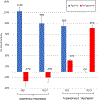Using Estrogenic Activity and Nontargeted Chemical Analysis to Identify Contaminants in Sewage Sludge
- PMID: 33909413
- PMCID: PMC8378343
- DOI: 10.1021/acs.est.0c07846
Using Estrogenic Activity and Nontargeted Chemical Analysis to Identify Contaminants in Sewage Sludge
Abstract
Diverse organic compounds, many derived from consumer products, are found in sewage sludge worldwide. Understanding which of these poses the most significant environmental threat following land application can be investigated through a variety of predictive and cell-based toxicological techniques. Nontargeted analysis using high-resolution mass spectrometry with predictive estrogenic activity modeling was performed on sewage sludge samples from 12 wastewater treatment plants in California. Diisobutyl phthalate and dextrorphan were predicted to exhibit estrogenic activity and identified in >75% of sludge samples, signifying their universal presence and persistence. Additionally, the application of an estrogen-responsive cell bioassay revealed reductions in agonistic activity during mesophilic and thermophilic treatment but significant increases in antagonism during thermophilic treatment, which warrants further research. Ten nontarget features were identified (metoprolol, fenofibric acid, erythrohydrobupropion, oleic acid, mestranol, 4'-chlorobiphenyl-2,3-diol, medrysone, scillarenin, sudan I, and N,O-didesmethyltramadol) in treatment set samples and are considered to have influenced the in vitro estrogenic activity observed. The combination of predictive and in vitro estrogenicity with nontargeted analysis has led to confirmation of 12 estrogen-active contaminants in California sewage sludge and has highlighted the importance of evaluating both agonistic and antagonistic responses when evaluating the bioactivity of complex samples.
Figures


Similar articles
-
Chemical and biological analysis of endocrine-disrupting hormones and estrogenic activity in an advanced sewage treatment plant.Environ Toxicol Chem. 2008 Aug;27(8):1649-58. doi: 10.1897/07-519. Epub 2008 Mar 3. Environ Toxicol Chem. 2008. PMID: 18315391
-
Analyzing a broader spectrum of endocrine active organic contaminants in sewage sludge with high resolution LC-QTOF-MS suspect screening and QSAR toxicity prediction.Environ Sci Process Impacts. 2019 Jul 17;21(7):1099-1114. doi: 10.1039/c9em00144a. Environ Sci Process Impacts. 2019. PMID: 31179481 Free PMC article.
-
Evaluation of the in vitro estrogenicity of emerging bisphenol analogs and their respective estrogenic contributions in municipal sewage sludge in China.Chemosphere. 2015 Apr;124:150-5. doi: 10.1016/j.chemosphere.2014.12.017. Epub 2014 Dec 26. Chemosphere. 2015. PMID: 25548037
-
Fate of estrogenic hormones in wastewater and sludge treatment: A review of properties and analytical detection techniques in sludge matrix.Water Res. 2012 Nov 15;46(18):5813-33. doi: 10.1016/j.watres.2012.08.002. Epub 2012 Aug 17. Water Res. 2012. PMID: 22939851 Review.
-
Ecological risk of estrogenic endocrine disrupting chemicals in sewage plant effluent and reclaimed water.Environ Pollut. 2013 Sep;180:339-44. doi: 10.1016/j.envpol.2013.05.006. Epub 2013 Jun 2. Environ Pollut. 2013. PMID: 23735815 Review.
Cited by
-
Developmental programming: Sex-specific effects of prenatal exposure to a real-life mixture of environmental chemicals on liver function and transcriptome in sheep.Environ Pollut. 2025 Feb 15;367:125630. doi: 10.1016/j.envpol.2025.125630. Epub 2025 Jan 3. Environ Pollut. 2025. PMID: 39756566
-
Identification of Mid-Polar and Polar AhR Agonists in Cetaceans from Korean Coastal Waters: Application of Effect-Directed Analysis with Full-Scan Screening.Environ Sci Technol. 2023 Oct 17;57(41):15644-15655. doi: 10.1021/acs.est.3c04311. Epub 2023 Oct 3. Environ Sci Technol. 2023. PMID: 37787753 Free PMC article.
-
Exploring chemical space in non-targeted analysis: a proposed ChemSpace tool.Anal Bioanal Chem. 2023 Jan;415(1):35-44. doi: 10.1007/s00216-022-04434-4. Epub 2022 Nov 26. Anal Bioanal Chem. 2023. PMID: 36435841 Free PMC article.
-
Combining Nontargeted Analysis with Computer-Based Hazard Comparison Approaches to Support Prioritization of Unregulated Organic Contaminants in Biosolids.Environ Sci Technol. 2024 Jul 9;58(27):12135-12146. doi: 10.1021/acs.est.4c02934. Epub 2024 Jun 25. Environ Sci Technol. 2024. PMID: 38916220 Free PMC article.
-
A Review of Wastewater-Based Epidemiology Studies for the Assessment of Over-the-Counter Medicines Used as Recreational Drugs: The Example of Dextromethorphan.Med Sci Monit. 2024 Jun 21;30:e944120. doi: 10.12659/MSM.944120. Med Sci Monit. 2024. PMID: 38902914 Free PMC article. Review.
References
-
- Bergman K, Heindel JJ, Jobling S, Kidd KA, Zoeller RT. State of the Science of Endocrine Disrupting Chemicals- 2012: An Assessment of the State of the Science of Endocrine Disruptors.; 2013. doi:10.1016/j.toxlet.2012.03.020 - DOI
Publication types
MeSH terms
Substances
Grants and funding
LinkOut - more resources
Full Text Sources
Other Literature Sources

